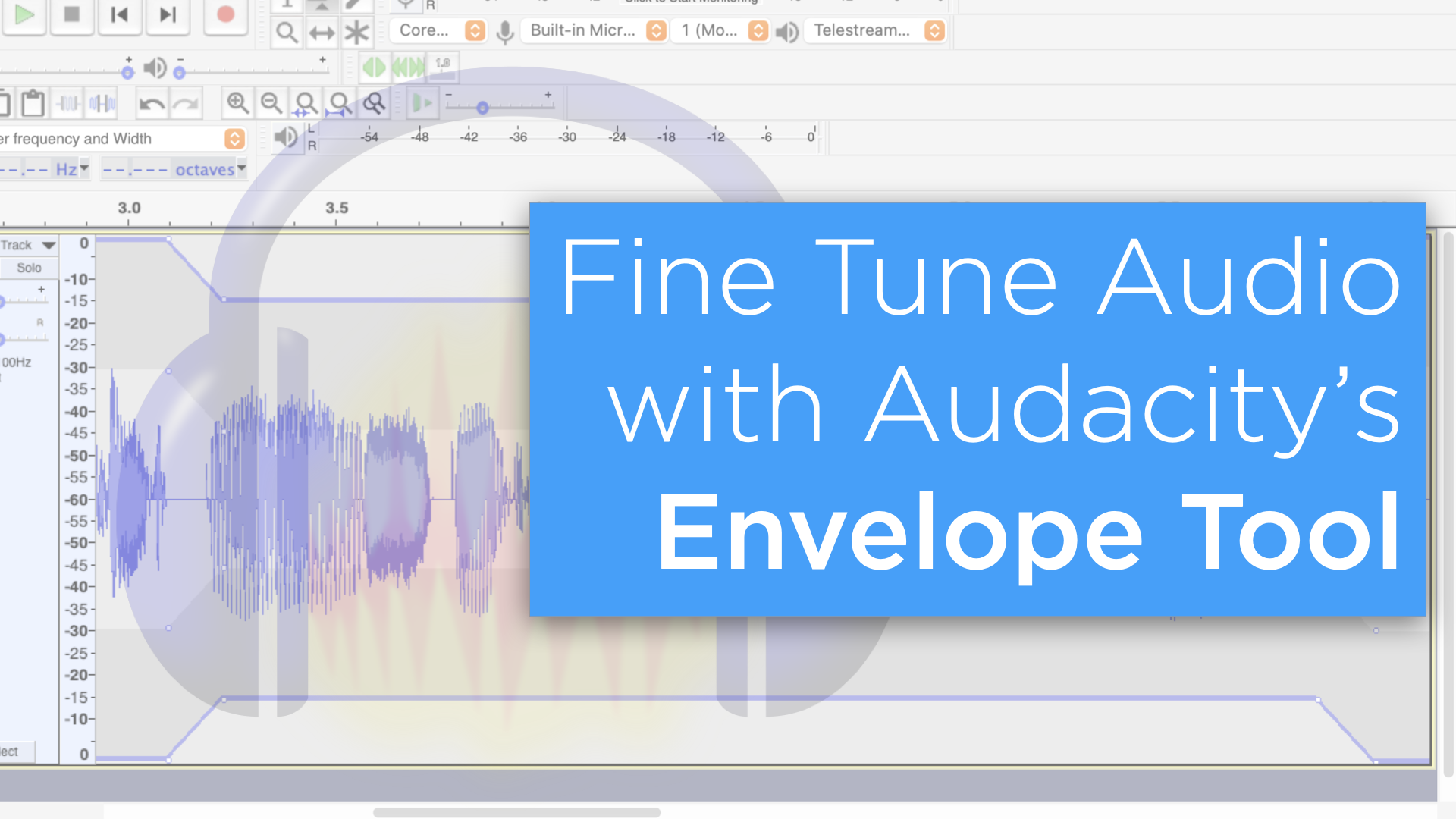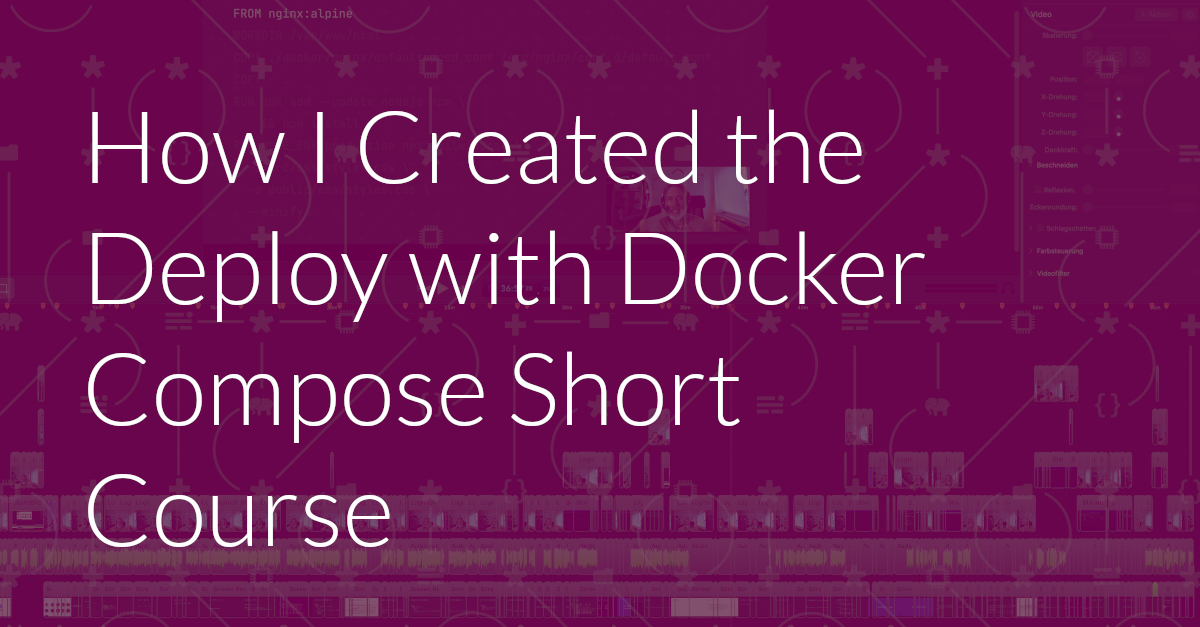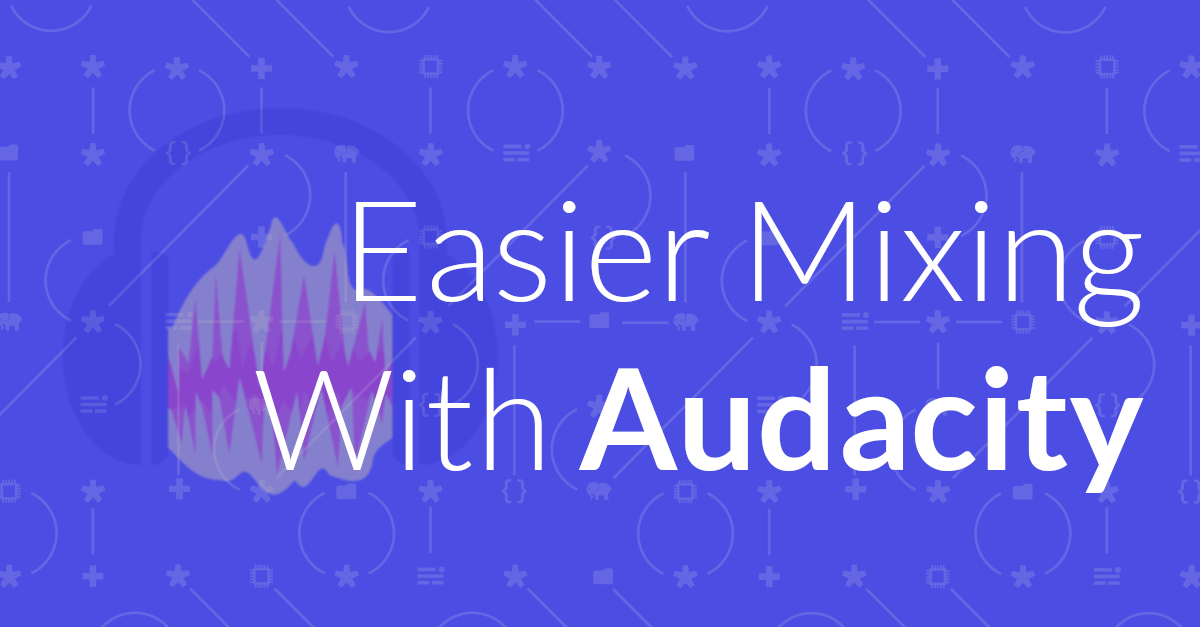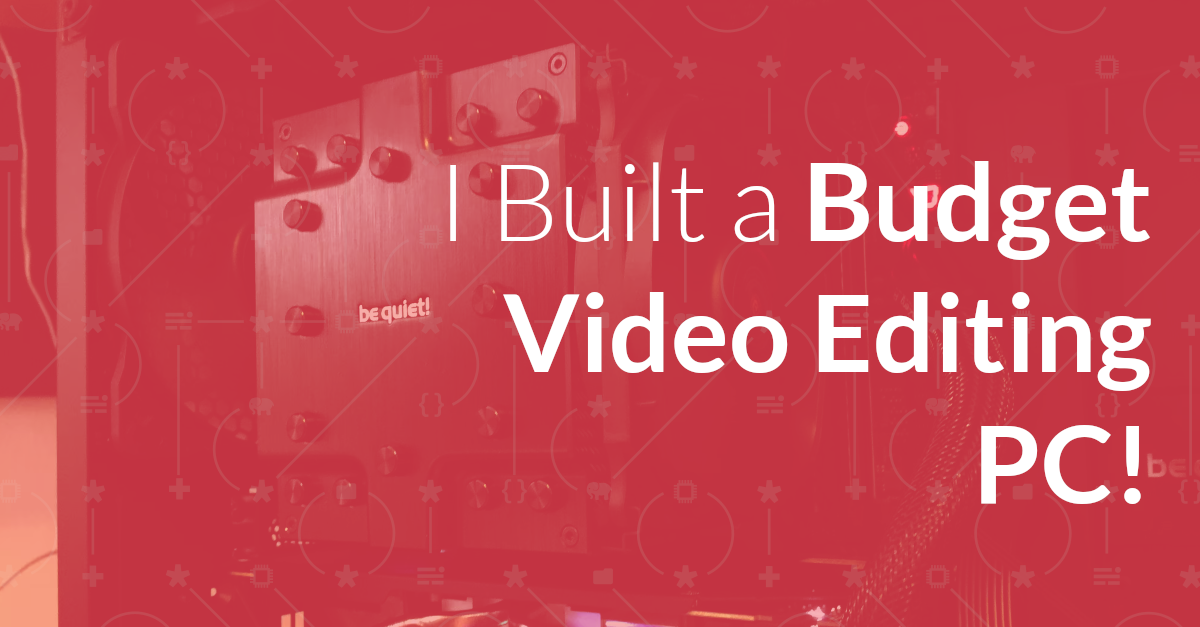Yesterday, I published a short course on deploying with Docker Compose to my YouTube channel. In this post, Today, I’m stepping through what it took to create the short course, from start to finish.
:idseparator: -
:idprefix:
:experimental:
:imagesdir: /images
I recorded the talk and myself as a talking head
image:posts/short-course/screenflow-screenshot.png[]
While I’ve been using https://www.blackmagicdesign.com/products/davinciresolve[Davinci Resolve] for video editing (on Linux) over the last couple of months, it wasn’t the right choice for this project.
I used https://www.telestream.net/screenflow/overview.htm[Screenflow 9] instead.
There were two key reasons for doing so.
Firstly, the slide deck which forms the core of the course was created in Apple Keynote.
Sure, LibreOffice does open Keynote files, so I could have run through the presentation on Linux, however attempting to do so is, let’s just say, less than desirable.
Have a look at the three screenshots below and tell me if you think they look professional.
image:posts/libreoffice/broken-slide-one.png[Broken Keynote slide one in LibreOffice]
image:posts/libreoffice/broken-slide-two.png[Broken Keynote slide two in LibreOffice]
image:posts/libreoffice/broken-slide-three.png[Broken Keynote slide three in LibreOffice]
Now compare that with how it renders in Keynote, below.
image:posts/keynote/the-short-course-in-keynote.png[The original Keynote presentation]
Perhaps if I’d created the slide deck directly in LibreOffice, it would have rendered as expected.
Regardless, it’s something learned for the future.
On a side note, another option I’m considering exploring for future presentations is Reveal.js, an open source HTML presentation framework.
But more on that another time.
Secondly, Screenflow is perfect for this kind of scenario (and Davinci Resolve doesn’t record your screen).
To create the source material, I started the presentation in Keynote then started a new Screenflow recording session.
All I needed to do was tell Screenflow to record my webcam, my main screen, and to record my voice from my main microphone.
This is one of the reasons that I don’t exclusively use Linux.
While I love https://en.wikipedia.org/wiki/GNOME_Shell[Gnome Shell] and use it for over 90% of my daily work, sometimes macOS is the right choice.
That said, in the future, I’d like to record more content in Linux.
But, so far, I’ve not done a lot of screen recording on Linux.
Given that, I’m not quite sure what combination of software I’d need to record an equivalent session.
A third reason is that I’m quite experienced with Screenflow (up to version 9), as I’ve created a number of online courses using it over the last 5 or so years.
Given that, I have a lot of muscle memory that helps me use it quite efficiently.
Back to the recording process.
I then stepped through the presentation from start to finish, re-recording parts where I flubbed the audio or where I ad-libbed some points but which made little to no sense.
In the screenshot below, you can see just how many cuts I’ve made, which should give an indication of how much content fell on the cutting room floor.
image:posts/screenflow/editing-in-screenflow-showing-significant-work-in-the-timeline.png[Editing the short course in Screenflow focusing on the timeline]
Did I mention that the just over an hour recording in Screenflow weighed in at [.underline]29 GB.
That’s a lot of data!
It’s at moments like this that I’m glad that I invested in a proper NAS with terabytes of space, so that I can back it all up.
Regardless, now, I was then ready to clean it up in post-production.
I cleaned up and polished the presentation in post-production
I removed unnecessary content
If you’ve ever created a course (say for https://www.pluralsight.com/authors/matthew-setter[Pluralsight]), or a video of any length to be https://www.youtube.com/webdevwithmatt[shared on YouTube], Vimeo, or Wistia, etc, then you’ll be familiar with https://wistia.com/learn?page=1&tag=post-production[post-production].
It’s when you remove the ums, ahs, errs, multiple bad takes of some section of text, empty space, mouth noises and so on.
It’s also the time when you add in effects, text overlays, and, sometimes, many other cool parts of the presentation.
While it’s essential for a polished recording, and can be fun, it can also be tedious.
For this course, however, I only did the following:
- Added in live demos
- Added in my talking head, where it made sense
- Added in text overlays
For the first time – ever – I didn’t have to touch the audio.
I left the audio as it was
This might sound strange if you’re used to doing lots of audio clean-up work.
It used to be quite a tedious task until I had sufficiently mastered link:/tags/audacity/[Audacity].
However, I don’t have to do that any more.
image:posts/dbx286s/dbx286s-microphone-processor-better-quality.jpg[The dbx 286s microphone processor on my desk]
Howver, some months back, I bought a https://www.thomannmusic.com/dbx_286_s.htm[dbx 286s microphone processor], which you can see above, thanks to advice from my content creation mentor https://shawnhesketh.com/[Shawn Hesketh].
If you’ve never heard of the dbx 286s, it’s a magical box that makes your source audio sound so much better than it normally would. For example, it can:
- Smooth out uneven vocals
- Remove low frequency hums (such as from electrical cables), wind, and neighbours using chainsaws when you’re recording
- Eliminate vocal sibilance and plosives
- Add fullness and depth to your voice, for that professional radio studio sound
- Make a recording less “muddy”, clearer, and crisper, if that’s your preference
Sure, it costs around €180 or $275 USD new, and I was slow to buy one.
But if you’re creating enough content, I feel that https://www.thomannmusic.com/dbx_286_s.htm[it’s well worth the investment].
Why?
I no longer record my audio and then post-process it in Audacity.
As I have the 286s configured it as I need it, I talk into the microphone and the audio comes out nice and clean.
There’s precious little, if any, https://matthewsetter.com/make-your-voice-sound-sexy-with-audacity/[audio post-production in Audacity] that I now need to do.
This is an incredible time-saver, as you’ll likely appreciate.
I added in demos and overlayed my webcam
While I’ve refined the core presentation while delivering to 10 user groups, watching a slide deck for any length of time – regardless of the fact that I’m speaking enthusiastically – can get a little monotonous.
To help alleviate this, I sought to give the short course more energy and engagement in three ways.
1. Adding demos, where it made sense
image:posts/youtube/showing-a-demo-over-the-presentation.png[A still of me demoing a Docker Compose command in the short course]
For example, if you skip to https://www.youtube.com/watch?v=Zsu0gT59K4g?t=41m49s[41:49], you can see me building an image.
At https://www.youtube.com/watch?v=Zsu0gT59K4g?t=43m04s[43:04] you can see me listing a series of images in the local Docker image cache.
I feel that, while I created the demos after the recording the demos still made the talk more interesting.
2. By overlaying the recording of me from my webcam
I overlayed my webcam video so that you see my face and hear my voice.
I’m not visible throughout the entirety of the short course.
That’d be too much of a good thing 😊.
But seriously, it wouldn’t make sense, and each section has a slide to introduce it, so that it’s clearer as to where sections start.
The video overlay is mostly displayed on the lower right-hand side, but not always.
Sometimes, based on the current slide or the demo, it might not make sense to do so.
In those cases, I moved it to a more appropriate position.
image:posts/screenflow/editing-in-screenflow-showing-clip-layers-small.png[Showing how I overlayed my webcam in Screenflow]
Screenflow makes it pretty trivial to layer one video (or clip) over another.
Similar to image manipulation software, such as https://www.gimp.org/[Gimp], https://www.pixelmator.com/pro/[Pixelmator], or Photoshop the uppermost clip (or layer) is at the front, with each successively lower clip/layer being behind the one above it.
I experimented with where the clip seemed to make the most sense, then created a preset.
That way, I could select all of the relevant clips, apply the preset and know that they’d all be in the same position throughout the short course.
3. I added text overlays
This was added to clearly show the URL for https://deploywithdockercompose.com[Deploy with Docker Compose], which was on the screen at the time.
The motivation for this was that the URL bar was quite small, making the URL easy to miss, and I only spoke the URL once.
The text overlay had a soft background so that the text was easy to read, regardless of what was in the background behind it.
image:posts/youtube/showing-a-url-with-a-text-overlay-in-screenflow.png[Showing a text overlay in the short course]
I don’t really add too many overlays or effects to my videos and courses.
I’m a big believer in the old adage of “less is more” and that if you add too much of a good thing, you can ruin the entire work.
Where effects make sense, I’m fine with using them.
But nowhere else!
Like so many other video applications, Screenflow offers https://youtu.be/q7FpywaETzM[a host of effects], such as annotations, callouts, video, audio, and mouse/pointer effects.
But I didn’t see the need for the majority of them in this case.
I exported the presentation directly to YouTube
This was virtually a no-brainer, as in addition to a dedicated export functionality, where you can choose down to a granular level how you want to export your video, Screenflow also offers custom exports designed specifically for YouTube, Vimeo, Google Drive, Wistia, and more.
image:posts/screenflow/export-to-youtube-step-one-small.png[Publishing to YouTube in Screenflow step one]
Step by step, I clicked menu:File[Publish to > YouTube…] and authenticated to YouTube, as the previous session had logged out.
I accepted the defaults in the first step (above) as they suited the project.
image:posts/screenflow/export-to-youtube-step-two-small.png[Publishing to YouTube in Screenflow step two]
Then, I filled in the category, title, description, tags, thumbnail, and visibility settings in the second step (above) and clicked btn:[Publish].
Each field is required.
Then, a little while later, owing to the size of the video, it was https://www.youtube.com/watch?v=Zsu0gT59K4g[uploaded to YouTube].
The entire process was pretty trivial.
Thanks, Screenflow!
That’s how I created my Deploy With Docker Compose short course
Primarily thanks to the ease of use of Screenflow and the time saving that the dbx 286s gives me, as well as prior experience creating courses, creating the short course was a pretty straightforward process.
While I’m always on the lookout for new ways to improve, refine and simplify my process, this is where I’m up to.
I appreciate that I didn’t cover the design of the course, or creating it in Keynote.
What I wanted to focus on was the creation of the short course from the completed presentation.
If you’re interested in actual course design, let me know in the comments.
If there’s enough interest, I’ll create a dedicated article stepping through how I do that.
Do you create online courses?
What’s your approach?
Please share it in the comments.
I’d love to learn from you as well.




Join the discussion
comments powered by Disqus